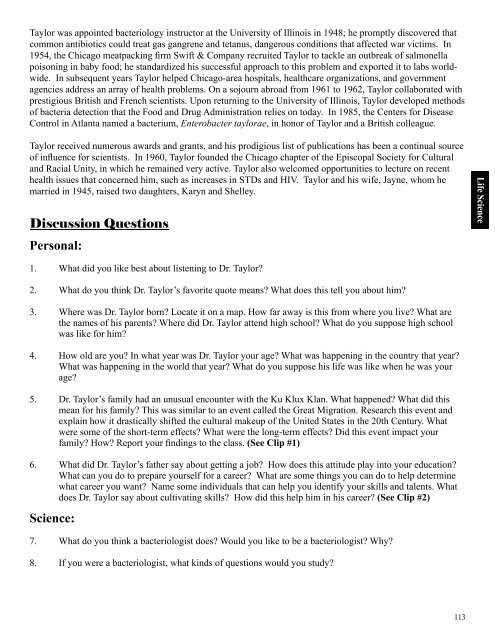ScienceMakers Toolkit Manual - The History Makers
ScienceMakers Toolkit Manual - The History Makers
ScienceMakers Toolkit Manual - The History Makers
You also want an ePaper? Increase the reach of your titles
YUMPU automatically turns print PDFs into web optimized ePapers that Google loves.
Taylor was appointed bacteriology instructor at the University of Illinois in 1948; he promptly discovered that<br />
common antibiotics could treat gas gangrene and tetanus, dangerous conditions that affected war victims. In<br />
1954, the Chicago meatpacking fi rm Swift & Company recruited Taylor to tackle an outbreak of salmonella<br />
poisoning in baby food; he standardized his successful approach to this problem and exported it to labs worldwide.<br />
In subsequent years Taylor helped Chicago-area hospitals, healthcare organizations, and government<br />
agencies address an array of health problems. On a sojourn abroad from 1961 to 1962, Taylor collaborated with<br />
prestigious British and French scientists. Upon returning to the University of Illinois, Taylor developed methods<br />
of bacteria detection that the Food and Drug Administration relies on today. In 1985, the Centers for Disease<br />
Control in Atlanta named a bacterium, Enterobacter taylorae, in honor of Taylor and a British colleague.<br />
Taylor received numerous awards and grants, and his prodigious list of publications has been a continual source<br />
of infl uence for scientists. In 1960, Taylor founded the Chicago chapter of the Episcopal Society for Cultural<br />
and Racial Unity, in which he remained very active. Taylor also welcomed opportunities to lecture on recent<br />
health issues that concerned him, such as increases in STDs and HIV. Taylor and his wife, Jayne, whom he<br />
married in 1945, raised two daughters, Karyn and Shelley.<br />
Discussion Questions<br />
Personal:<br />
1. What did you like best about listening to Dr. Taylor?<br />
2. What do you think Dr. Taylor’s favorite quote means? What does this tell you about him?<br />
3. Where was Dr. Taylor born? Locate it on a map. How far away is this from where you live? What are<br />
the names of his parents? Where did Dr. Taylor attend high school? What do you suppose high school<br />
was like for him?<br />
4. How old are you? In what year was Dr. Taylor your age? What was happening in the country that year?<br />
What was happening in the world that year? What do you suppose his life was like when he was your<br />
age?<br />
5. Dr. Taylor’s family had an unusual encounter with the Ku Klux Klan. What happened? What did this<br />
mean for his family? This was similar to an event called the Great Migration. Research this event and<br />
explain how it drastically shifted the cultural makeup of the United States in the 20th Century. What<br />
were some of the short-term effects? What were the long-term effects? Did this event impact your<br />
family? How? Report your fi ndings to the class. (See Clip #1)<br />
6. What did Dr. Taylor’s father say about getting a job? How does this attitude play into your education?<br />
What can you do to prepare yourself for a career? What are some things you can do to help determine<br />
what career you want? Name some individuals that can help you identify your skills and talents. What<br />
does Dr. Taylor say about cultivating skills? How did this help him in his career? (See Clip #2)<br />
Science:<br />
7. What do you think a bacteriologist does? Would you like to be a bacteriologist? Why?<br />
8. If you were a bacteriologist, what kinds of questions would you study?<br />
113<br />
Life Science










